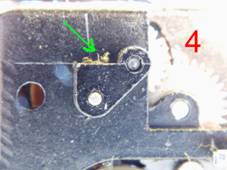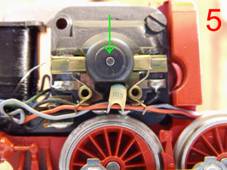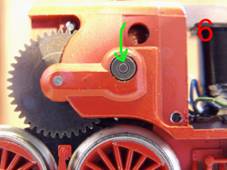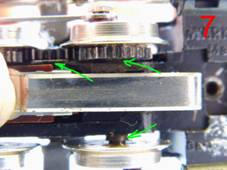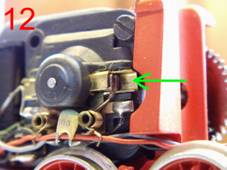|
|
||||
|
The Prototype Märklin-H0-Knowledge Layout-Building Modelstock |
||||
|
A: The very first
basic knowlege about conventionally controlled Märklin H0 model railways A11:
Maintenance – clean, lubricate,
replace |
||||
|
I
know of two detailed German brochures from Märklin on this subject for
conventional traction units: (click on the picture to open) |
||||
|
I'll
add my two cents here: Cleaning |
||||
|
Dust and grease/oil together form an insulating layer that settles on
the rails and on the running surfaces of the wheels (picture 1). Regularly vacuum dust from the tracks and degrease with a cleaning
agent. There are vacuum cleaner wagons from several manufacturers. The steam and cleaning oil SR24 and light petrol such as lighter fuel
and petroleum ether as well as isopropanol / isopropyl alcohol are suitable
for degreasing. Cleaning the wheel treads is tedious but rewarding. |
|
|||
|
The locomotive wheels must be kept clean as a matter of priority to
ensure trouble-free operation. The wheels of trailers with sliders must also be cleaned so that the
train lighting functions as uninterruptedly as possible. A glass fiber brush is suitable for cleaning, with the disadvantage of
the broken glass fibers which are unpleasant in your skin. Sanding blocks are available in various grit sizes. (picture 2) Some people use a sharp screwdriver blade or knife to scrape off the
layer. For wagon axles there is a cleaning device from the Lux company. The rails should never be sanded, because the dirt gets stuck in the
grooves that are created. If sanding is unavoidable, then smooth with the finest abrasive
afterwards and then polish. A blue ink eraser is also recommended. Isoprpanol / isopropyl alcohol is recommended for cleaning the rails. The centre conductor is kept bright by the grinders during regular
operation. After a longer period of non-use, a light oxide layer can form. Basic cleaning of second-hand locomotives Some people are too good at lubricating their locomotives. If you then take over a little treasure from them, it often makes sense
to carry out a basic cleaning. Even brand-new locomotives that have been in their box or in the display
case for years can be completely gummed up. If it hardly/never wants to run, just hums, then it is due for a
thorough cleaning. CAUTION: The cleaning methods practised are quite different:
For the last two procedures, it makes sense to remove the housing so
that the cleaning agent can reach everywhere - more disassembly is not
necessary. The electronics must be protected from the detergents, so do not immerse
them in the bath. For the last method, which I use myself, the above-mentioned SR-24 or
lighter fluid or petroleum ether is suitable as a cleaning bath. The latter,
however, is a fire hazard! An exposure time of 30 minutes can be enough to loosen the coatings. The insulating tape around the coil of the direction switch will come
off. Traction tyres become grippy again. You do not have to dismantle them. In SR-24, you can even run the engine to flush out the dirt from the
last corners. |
||||
|
To do this, connect test leads with crocodile clips to the slider (red
transformer connection) and e.g. to the buffer (brown transformer
connection). SR-24 is not conductive, so there is no short circuit. I show a video of this. |
||||
|
SR-24 is harmful to health, I show the German safety
data sheet. It is therefore surprising that
it is permissible to vaporise it in "children's toys". |
||||
|
Because of the possible fire/explosion hazard, I advise against running
it in petrol. After the bath, let the locomotive running gear drip off. The cleaning fluid remains in the spoke wheels and joints, so it makes
sense to blow off all sides of the locomotive. Then let it dry for a few hours. The bearings are now dry, so now it's time for lubrication.... Lubricating All bearings on Märklin models are slide bearings. These occasionally need "a trace" of oil. A trace means considerably less than a drop. Rather a light wetting, a
touch.... It is strongly recommended to use oil that is free of resin and acid. But even Märklin itself used oil in the 80s, which has gummed up over
the years. The recommendations of practitioners from the forums are:
Lubrication points: |
||||
|
Armature shaft When the locomotive starts to squeal, it is high time. On engines with disc collectors, there are lubrication pockets with foam
rubber filling above the armature shaft as a depot for the oil. (picture 3
and picture 4). |
|
|||
|
Motors with a drum collector have no lubrication pockets. Tiny drops are applied to the shaft ends there. (picture 5 and picture
6). |
|
|||
|
Axles Locomotive axles have internal bearings, they are inserted through the
frame. A trace of oil to the bearing point. (picture 7) |
|
|||
|
Axles of wagons are mounted on the outside, in needle bearings or tip
bearings. Opinions differ: clean and dry or lightly grease. Graphite is probably best here, because it does not attract dust. Gears and gears should be lightly greased rather than oiled. |
||||
|
The slider of the Reverse Unit should not be lubricated, at most with
graphite. (picture 8) |
|
|||
|
Wear parts A "wear part" is a component that is worn out under intended
use, worn out and then replaced. Exploded views and spare parts lists for traction units Exploded views and spare parts lists for accessories A list of spare parts for Märklin H0
locomotives from a supplier |
||||
|
Slider on the centre conductor (Picture 9) When grooves have formed and/or the silver coating has worn
through and the brass core is visible, it is time for replacement. The life of the sliders can be increased by making sure that the slider
is not bent. |
|
|||
|
The slider in the example picture is bent and therefore shows uneven
wear. The "brushes" on the motor collector On Märklin motors, two contacts are transferred to the armature (the
rotating part of the motor). The contact surfaces on the armature are called collector. The parts rubbing on the collector are called brushes. There are two collector forms: |
||||
|
1. the motor with disc collector (picture 10): Märklin no. 60 030
for the pair of brushes, consisting of a coiled copper net and a cylindrical
carbon with a slot. The retaining springs are shaped to fit: angled on the left for the hole
in the copper coil, straight on the right for the groove in the carbon. |
|
|||
|
2. the motor with drum collector (pictures 11 and 12): Märklin No.
60 146 for the pair of brushes, consisting of two square carbon pins with a
groove at one end. The retaining springs belong in the groove. |
|
|||
|
Traction tyres Märklin locomotives have at least one traction tyre. You can see where a traction tyre belongs by the groove in the wheel
tread. Without a traction tyre, the friction between the wheel and the rail is
very low. With a heavy locomotive and light wagons, this can still work on
horizontal track, but even tight curves or slight inclines can end the journey. Märklin offers traction tyres in 4 sizes as bags of 10:
The adhesive tyre is slightly smaller before mounting so that it sits
with tension on the wheel and does not slip. Over time, traction tyres become harder and more brittle. As a result, they grip increasingly poorly and can tear off. In the past, there were other sizes. For example, on the old E18 (3023/3024) the order number for the
adhesive tyres is 7148. For the new model of the E18, the order no. is 7153, so they should also
fit the old E18. If you search Ebay with these numbers, you will also find very cheap
imitations. They also work. There is also liquid rubber that you can fill into the groove with the
appropriate manual skills. Opinions on this vary widely... On my steam locomotives, the last driven axle almost always has 2
traction tyres. Exceptions:
Locomotives with bogies usually have 4 traction tyres on the driven
axles, even the 6-axle ones. The small diesel locomotives have 2 traction tyres on the rearmost axle. |
||||
|
The Prototype Märklin-H0-Knowledge Layout-Building Modelstock |
||||
|
state: 10.10.2023 20:01 |
||||
|
Contact:
Mail |
||||








